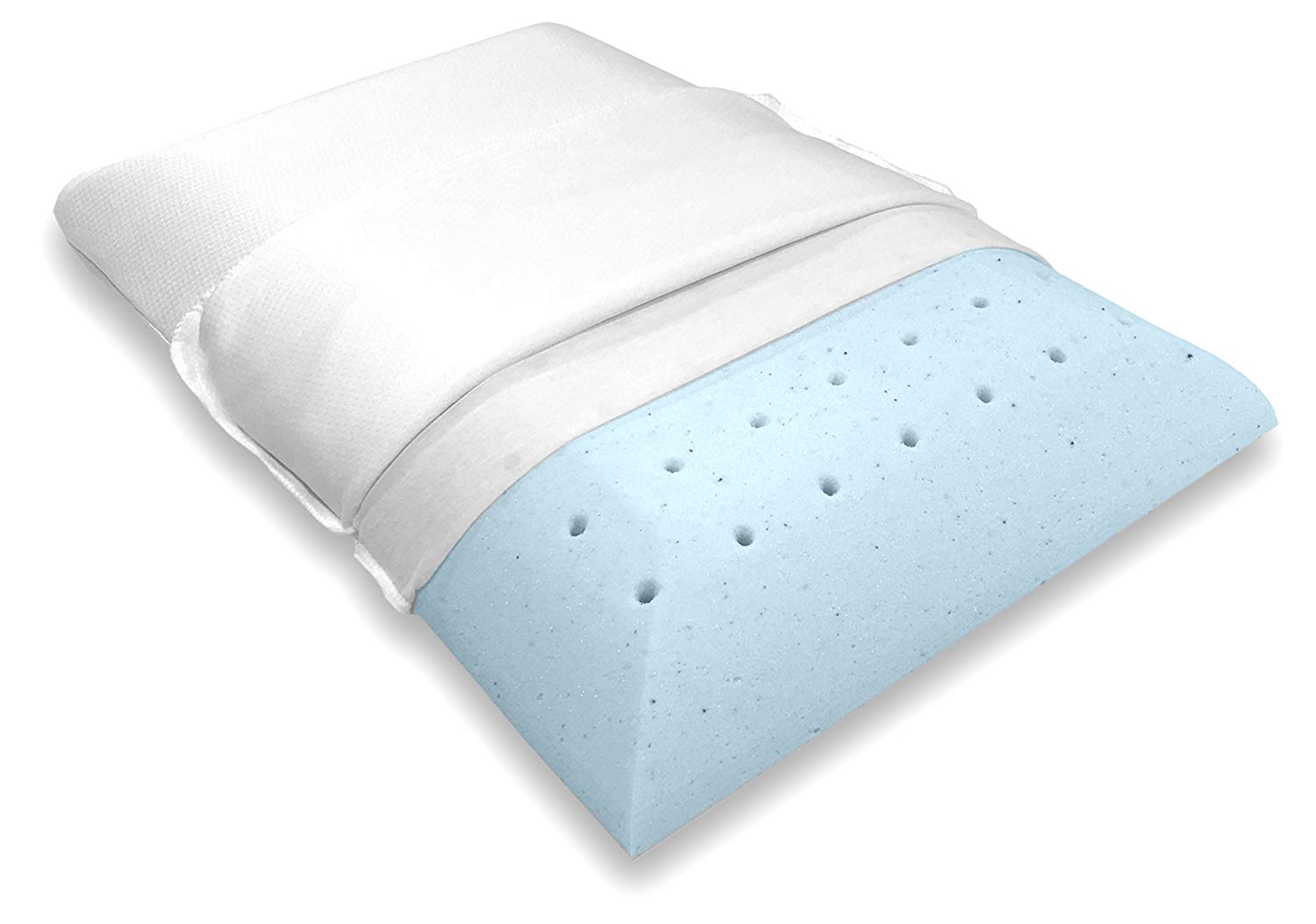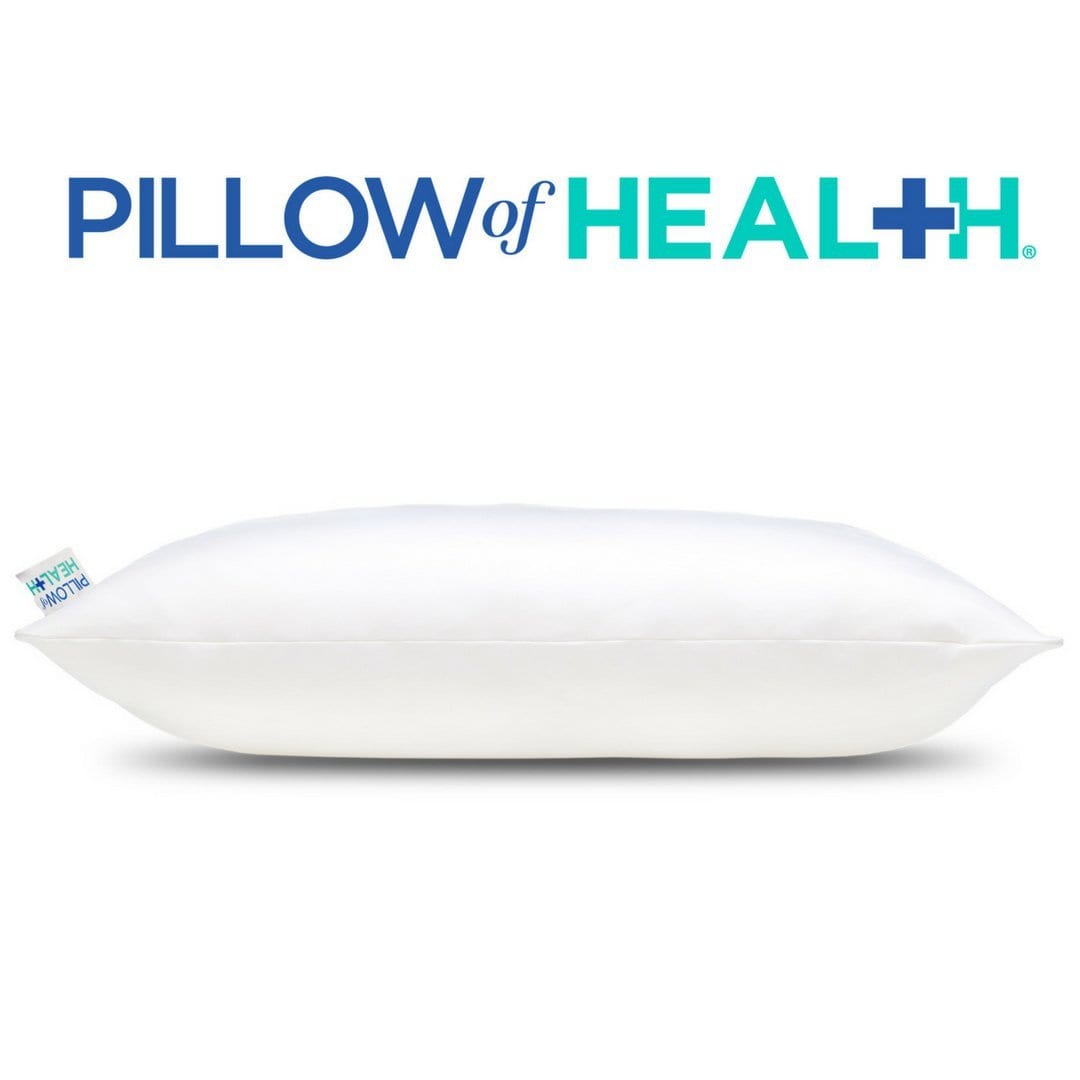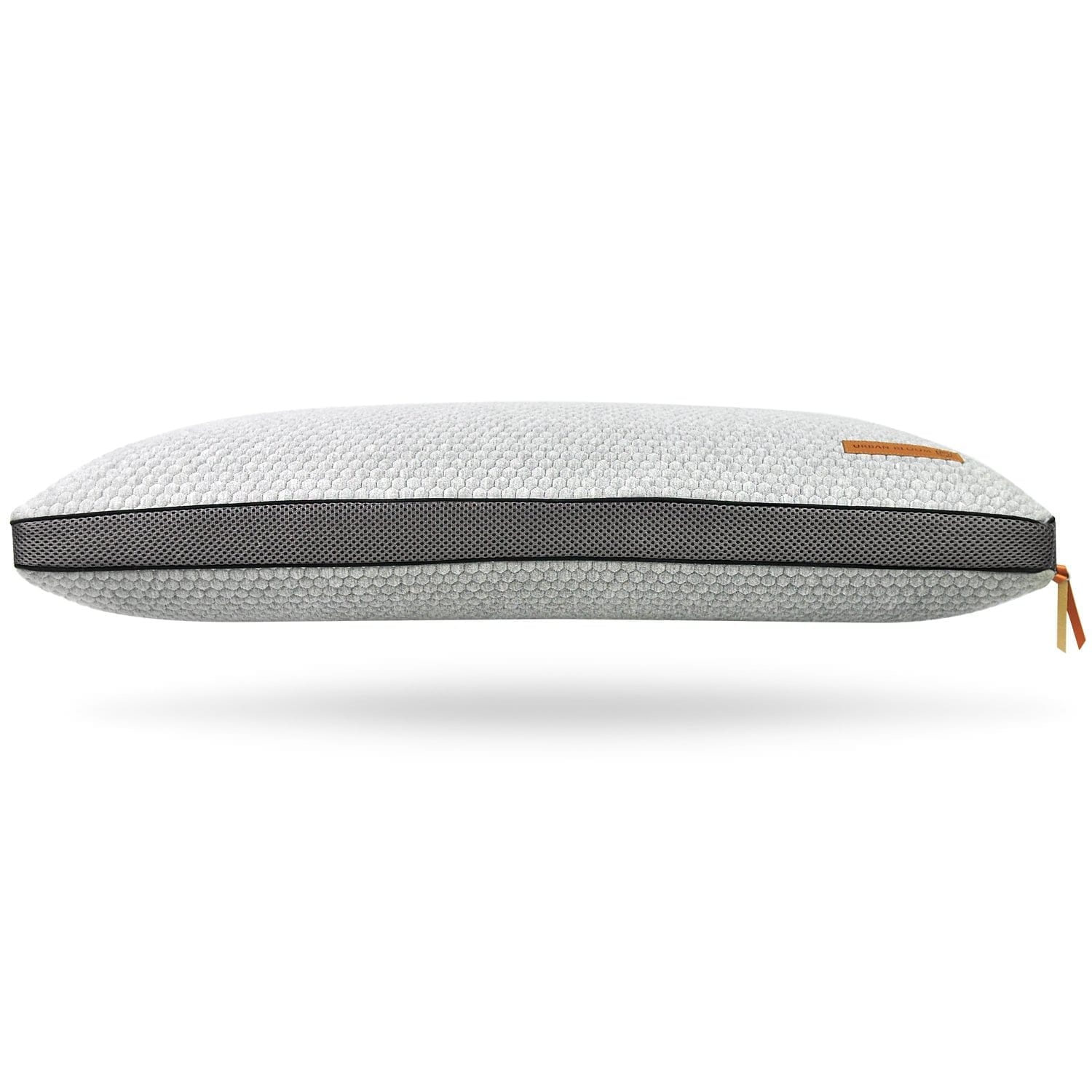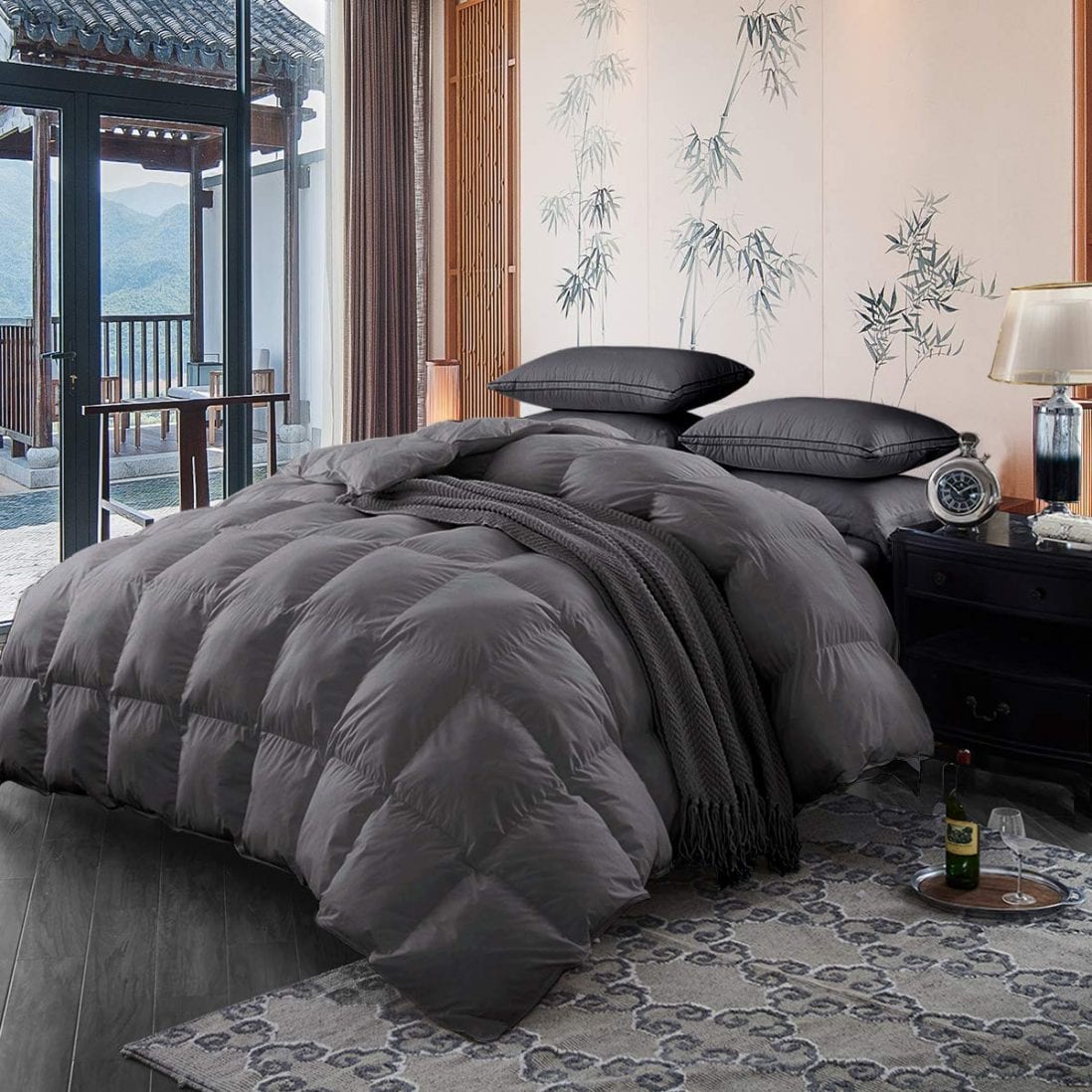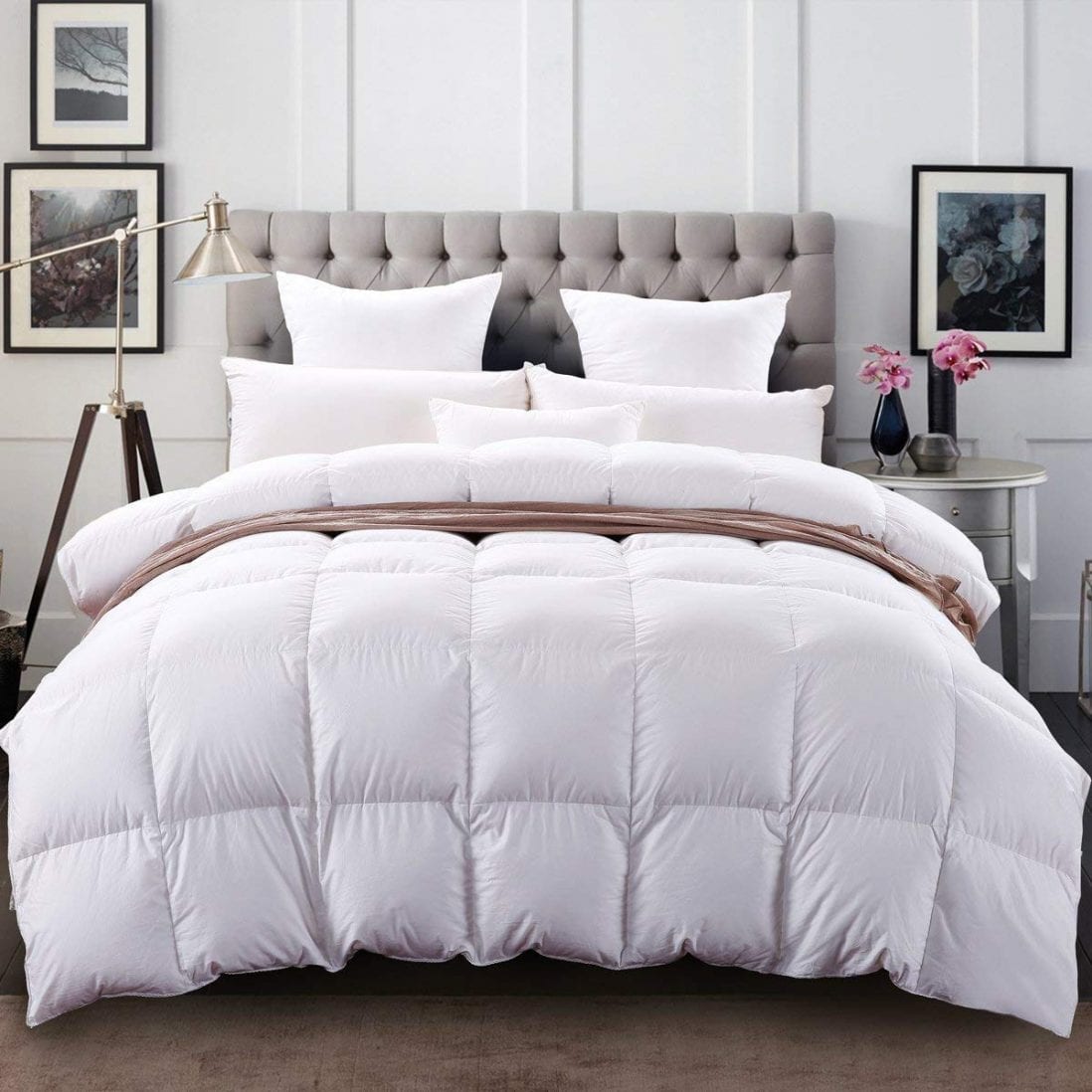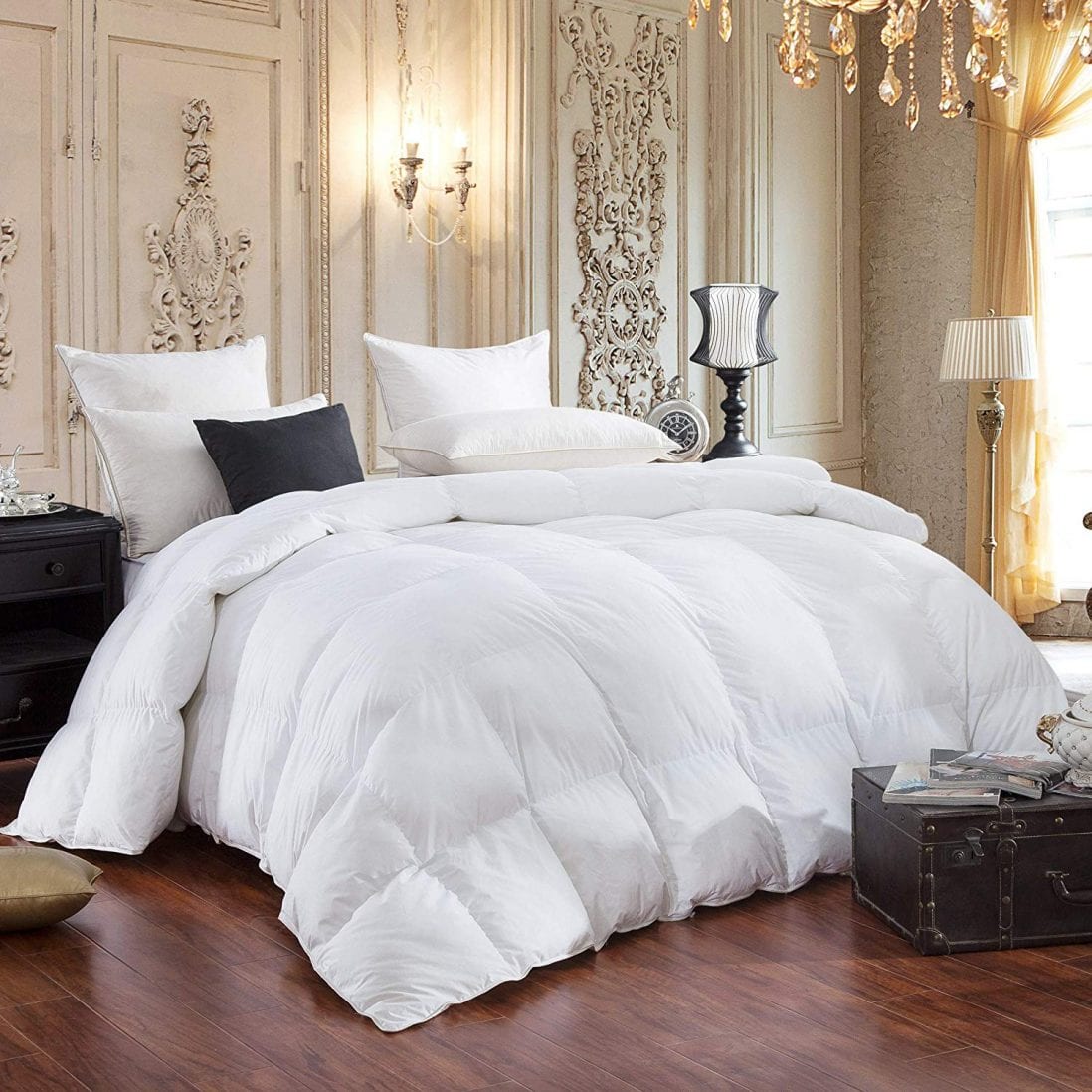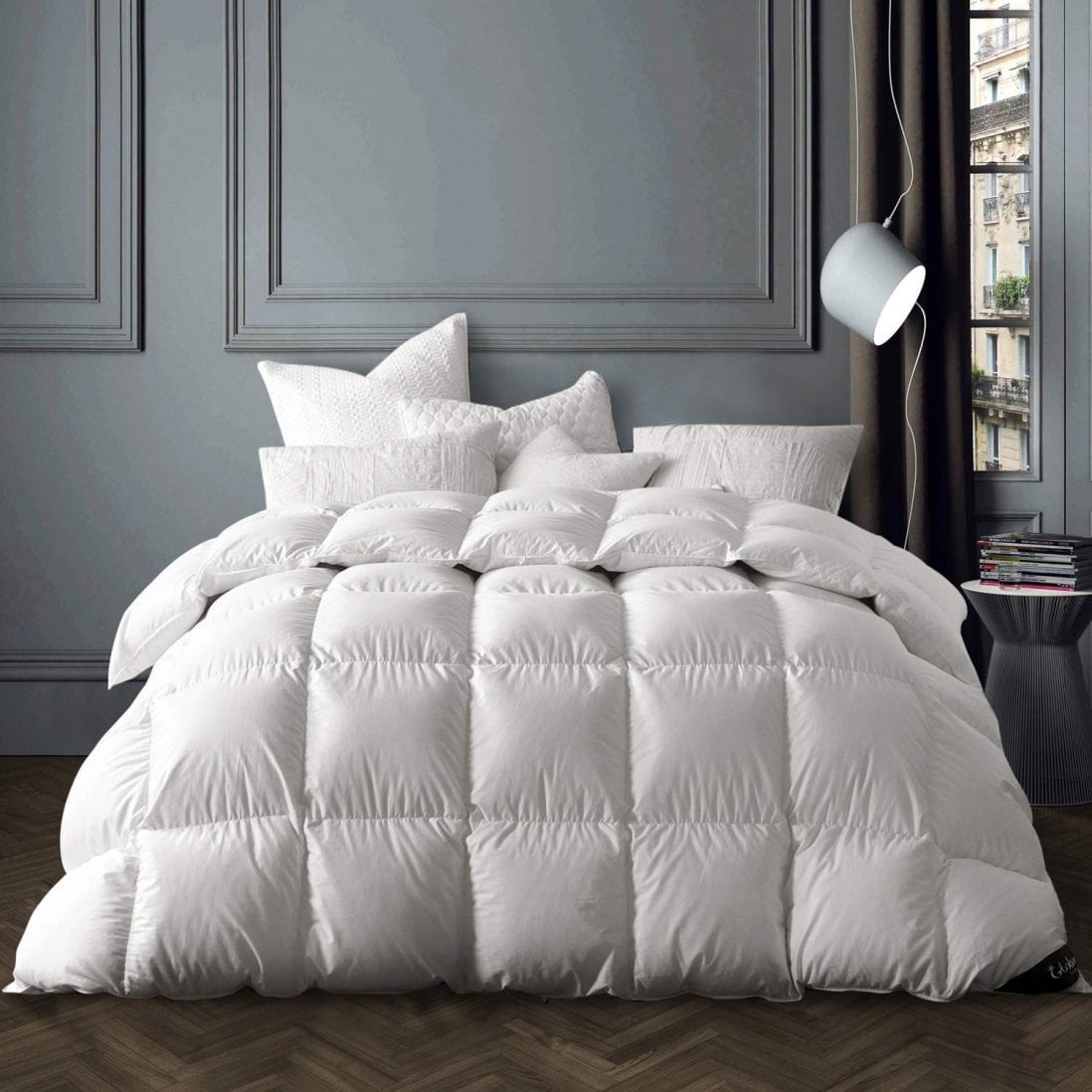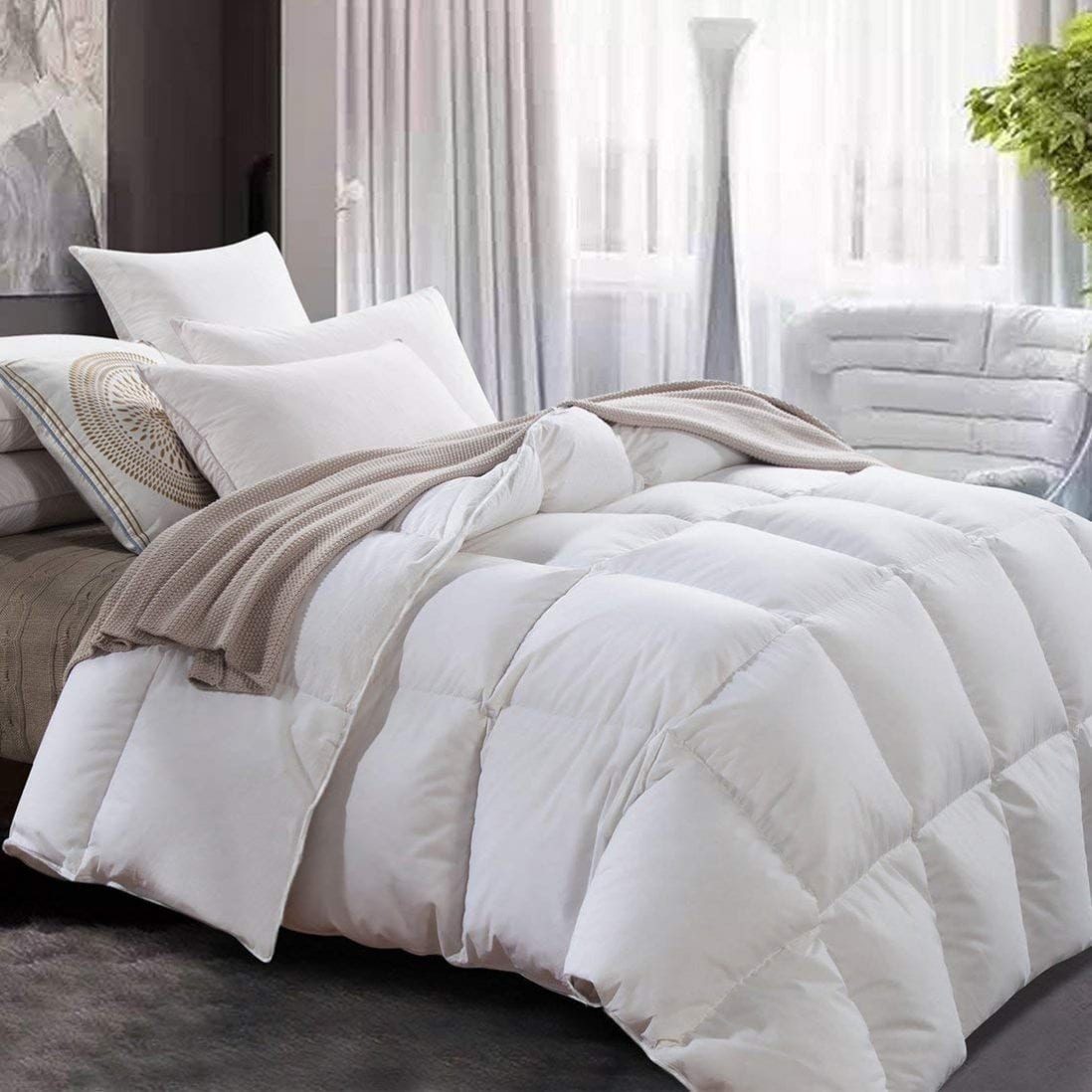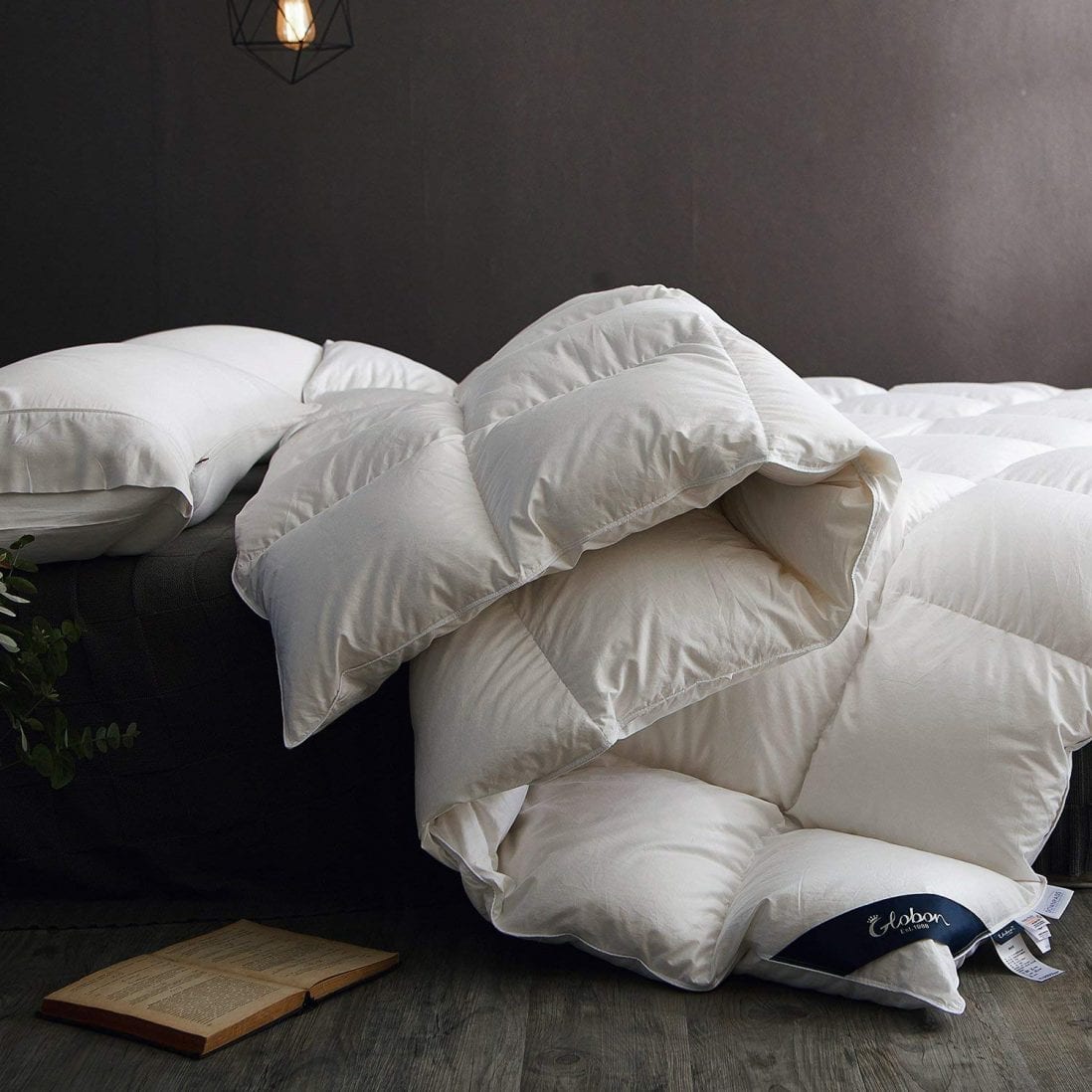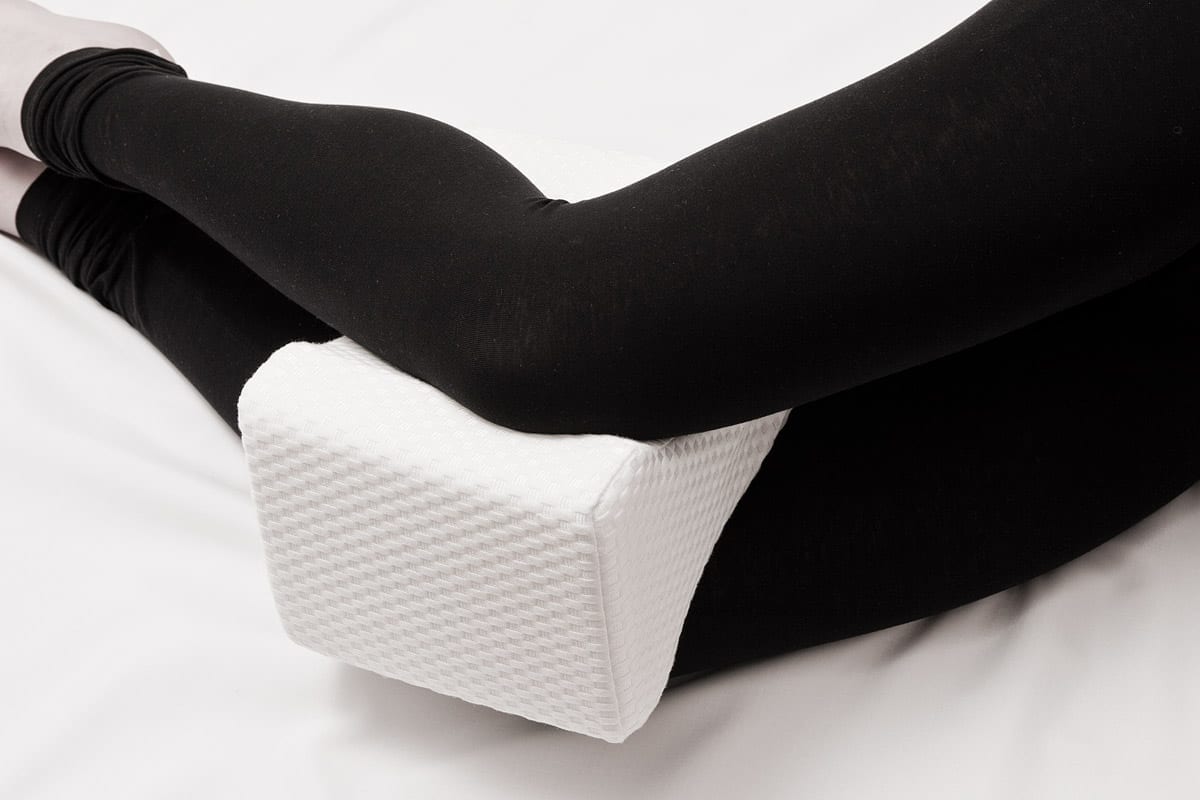On a cold winter night there’s nothing like getting in bed and snuggling under a cozy down comforter. If you don’t already have one, it’s time you learned about the best down comforters currently on the market. No other piece of bedding is as important as the right comforter, (a.k.a. duvet or duvet insert) when temperatures drop below freezing. Why not get the best comforter that money can buy?
The best comforters have some common characteristics: ample softness, warmth, breathability, and fluffiness. In order to determine which combination of these would make the perfect comforter for you, it’s important to consider whether you generally sleep hot, if you’re allergic to feathers and how much you’d be comfortable spending.
There are a couple of key factors that affect most of these elements: fill power and the thread count of the outer shell:
- Fill power: How high the down filling puffs up, which is determined by the quality of the goose down. The higher the fill power, the lighter, puffier, warmer, and longer lasting the comforter.
- Thread count: A measure of how tightly woven the fabric is woven on the shell. The higher the thread count, the less breathable and warmer the comforter.
A comforter that has both high fill power and high thread count would provide extreme warmth and insulation.
There are so many options to choose from it wouldn’t be surprising if you felt overwhelmed, a lot of people do. It’s not easy trying to understand all the differences in order to figure out which one would make you the most comfortable, one within your budget.
To help you out, we’ve made a list of the ones we consider the best down comforters currently on the market. We’ve also put together an informative guide that gives you all you basically need to know to choose the one that will best meet your needs.
The Best Down Comforters
- SNOWMAN: the best for color option
- C&W: the best Siberian white goose down comforter
- Egyptian Bedding: the best Egyptian cotton option
- Globon: the best choice for sateen weave
- Egyptian Bedding: the best for thread count
- DOWNCOOL: the best lightweight down and feather option
- ROYALAY: the best for all seasons
- Globon: the best cotton shell option
- Utopia Bedding: the best down alternative budget option
Table of Contents
The research done on this website is made possible by commissions earned through sales from affiliate links shared within the content. Learn more here.
Down Comforters Comparison Table
Picture | Product | Key Features | Price |
|---|---|---|---|
- 100% cotton shell with 1200 thread count | |||
- Extremely soft and luxurious | |||
- 100% Egyptian cotton shell | |||
- 400 thread count sateen-weave 100% cotton cover | |||
- 1000 thread count 100% cotton cover - White goose down filling with fill power of 700+ | |||
- Breathable 100% cotton shell | |||
- Filled with ultra-soft Siliconized Fiberfill |
Down Comforters Reviews
SNOWMAN Review: The Best Down Comforter For Color Option
If you want something other than a standard white down comforter, the SNOWMAN comes in a variety of color options, including blue, khaki, and coffee. The 100% cotton shell is soft and durable, with a 1200 thread count and double-stitch design to keep the white down filling from poking out. This comforter has an extremely light and fluffy feel. The premium baffle box stitching keeps the filling from shifting, giving you maximum warmth and loft. Corner tabs help secure a duvet cover, so it stays in place.
This comforter must be dry cleaned only, without using any form of bleach whatsoever. Buying a duvet cover would be a good idea if you choose to get an all-white option. This will help it stay clean for a longer period of time.
We commonly hear consumers complain about the lack of color options in natural down comforters, but you won’t have that problem with the SNOWMAN. However, this means there are synthetic dyes used in the manufacturing process, so these comforters would not be hypoallergenic and natural, especially if you chose bright colors. SNOWMAN offers customers a 100% money-back guarantee if you return the comforter within 30 days.
C&W Review: The Best Siberian White Goose Down Comforter
This C&W goose down comforter is the epitome in understated elegance and does not get the credit it deserves for its luxurious feel and comfort. The 1200 thread-count cover is a blend of 20% Egyptian cotton and 80% polyester. This finely woven fabric keeps the down from poking out, and it’s not only soft but durable. The filling is 100% goose down, which offers great insulation properties due to the 750+ fill power and 50 oz. fill weight.
The down clusters are huge, so the comforter has no problem staying light and fluffy. If you want a truly luxurious bed that you can’t wait to crawl into every night, this C&W comforter is perfect. While it keeps you warm and comfortable, you won’t get overheated because it’s very airy and breathable.
We are seeing the baffle box stitching returning to more bedrooms all the time because it really is the best way to keep the down filling in place for uniform warmth. If the comforter smells like goose down when you unpack the box, just air it out for a few hours to let the odor dissipate. You might also notice that the comforter isn’t as full and puffy as the photos when you first unpack it, it’s because it’s been compressed for shipping. Just fluff it up, and it will resume its naturally fluffy shape. Keep in mind that this comforter is not machine washable; it would need to be dry cleaned.
Overall, the C&W down comforter is wonderful in so many ways, including an affordable price tag. We have no idea why this luxurious Siberian white down comforter isn’t getting the attention it rightly deserves, but we promise that you won’t be disappointed if you decide to give it a try.
Egyptian Bedding Review: The Best Egyptian Cotton Option
Egyptian Bedding is known for producing some of the best down comforters ever made, and this one certainly lives up to that reputation. The Egyptian cotton cover is made of one of the most luxurious types of cotton in the world. The comforter has a fill power of 750 with a fill weight of 70 oz., which makes this perfect for cold winter nights.
The baffle-box design keeps the fluffy goose down filling evenly distributed across the surface so the down won’t gather all in one area, which could impede its ability to insulate the warmth. This Egyptian Bedding comforter is hypoallergenic, so it’s safe for people with allergies who want to enjoy the softness and comfort of natural goose down. The cotton cover has a thread count of 600, so it is sufficiently tightly woven to be durable and long-lasting.
While the Egyptian Bedding comforter might be too warm to be used all year long, but if you’re looking for a down comforter to keep you warm during the cold winter months, this is a great choice.
Globon Review: The Best Choice for Sateen Weave
This is definitely one of the best down comforters you can find, but it doesn’t come cheap. However, it’s made of high-quality materials and has a higher fill volume than many, so it should last you for years compared to some less expensive alternatives.
With 700 fill power, it holds plenty of white goose down to keep you warm and cozy at night. It has a Texcote nano-treated down filling, making it water repellant and fast-drying. Furthermore, it’s not only hypoallergenic; it also has very little odor.
The cover on this comforter is made of ultra-soft 100% sateen cotton with 400 thread count. It has a baffle-box design to keep the filling evenly distributed and to ensure maximum loftiness, resilience, and warmth. It also comes with piping and corner tabs for attaching a duvet cover.
This comforter is also OEKO-TEX certified for safety. Globon also takes pride in prioritizing sustainability. They do not get the down from live sources, but rather the food industry. If you live in a cold climate with freezing temperatures and need a heavy-duty warmth in the winter, this Globon comforter may be just what you need.
ROYALAY Review: The Best For All Seasons
The ROYALAY white goose down comforter is perfect for year-round use in most climates. It’s made with an ultra-soft 1000 thread count 100% cotton cover with double-stitched and piped seams so there will be no down leakage. It’s 700+ fill power insulates you well on cold winter nights, while being lightweight and breathable enough to keep you cool during the summer. Reviewers from all over the country agree that the ROYALAY comforter is comfortable through all seasons of the year.
The seams are piped and double stitched, meaning you should expect a durable and long-lasting product. Many use this comforter as a duvet insert, and it stays in place due to the reinforced corner loops. The comforter will arrive a little flat because it comes packaged in a small bag. It shouldn’t take long for it to fluff up nicely, so there is no need for concern.
Globon Review: The Best Cotton Shell Down Comforter
This cozy high-quality white goose down comforter with a fill power of 650 has a durable yet breathable 100% cotton outer shell. Globon’s proprietary Suprelle Fusion fill used in this comforter is a blend of white goose down with a high-tech ultra-soft down synthetic called Cocoon, which was developed in Germany by ADVANSA. Suprelle Fusion fill has less odor and provides better moisture absorption and wicking, fluffability, and breathability than nearly all other down fillings.
This makes for an extremely soft fluffy comforter that can easily be taken care of. It’s also nice and breathable for people who sleep hot. The Globon comforter has a baffle-box design with lovely piping, so the filling stays in place and provides maximum loft and warmth. It comes with 4 corner tabs for attaching a duvet cover.
The lightly brushed cotton outer shell provides a soft sleeping surface. This product is also OEKO-TEX certified, which means the goose down in the comforter is cruelty-free. This may not be the least expensive option available, but it has all the features and benefits that you know you want to have from a comforter on a cold winter night.
Utopia Bedding Review: The Best Down Alternative Budget Option
Many people love that luxuriously soft feel of a down comforter, but they prefer something less expensive in a synthetic. A good down alternative can give you the plushy feel of down at a very affordable price. Utopia Bedding has one of the best synthetic down comforters that money can buy.
The filling used in this comforter is Siliconized Fiberfill, which perfectly mimics the comfort of down and does not trigger the allergies that down often do. The cover is made of a microfiber material that keeps you from getting hot and sweaty in bed at night. The Utopia Bedding Siliconized Fiberfill comforter is designed to fit inside a duvet. The box-stitching and piped edges keep the filling from shifting, evenly distributed the filling throughout.
What’s also great about this comforter is that it’s machine washable. However, it’s important that you follow the manufacturer’s instructions to wash in cold water on the delicate or gentle cycle and tumble dry on low heat.
What Is A Down Comforter?
First, we want to explain what a comforter or duvet is exactly: It’s similar to a quilt, but with an insulating layer inside. The filling might be wool, cotton, silk, polyester, or other synthetic blends, but in this case, we’re talking about down.
The outer feathers on ducks and geese have quills that make it possible for the bird to fly, but beneath those feathers and covering the belly, you will find down. These are the tiny, very light and fluffy feathers that provide the bird with a protective covering to insulate and keep them warm.
Down comforters are filled with tiny, light, and fluffy feathers from the underbelly of ducks and/or geese. These comforters are incredibly soft, luxurious, warm, and cozy, which is why they’re so popular.
The Advantages & Disadvantages of Down Comforters
Many people can’t imagine sleeping with anything but a goose down comforter once they’ve tried one. But just as with every other product, down comforters have their advantages and some disadvantages as well:
Benefits
Durable & Long-Lasting
If you take care of your down comforter according to the manufacturer’s instructions, it could last you for decades.
Extremely Soft & Fluffy
Down comforters are extremely soft, with a luxuriously fluffy feel that makes your bed incredibly comfortable and inviting.
Lightweight
Because down feathers are so light and fluffy, a down blanket can keep you incredibly warm without feeling heavy. This way, you can move around in bed a lot easier, plus it makes it easier to store away during the hot summer months when you may not need it.
Warm & Cosy
Due to the nature of down feathers, their fluffiness and loft make it the warmest possible filling for a comforter, pound-for-pound.
Drawbacks
Most Require a Cover
Most down comforters are meant to be inserted inside a duvet cover, and if it isn’t secured properly at the corners, the comforter may slide around inside the cover.
More Difficult to Care For
Most down comforters are not machine washable, so they need to be dry cleaned. Generally, down blankets are more difficult to maintain than their cotton or synthetic-filled counterparts.
May Get Too Warm
People who tend to get hot and sweaty at night may get too warm under a down comforter. Others can use them comfortably in winter but find they get too hot during the summer.
May Cause an Allergic Reaction
Unfortunately, there are those who are allergic to feathers, and this includes down. These people have no choice but to avoid using down pillows or comforters altogether.
Things to Consider Before You Buy a Down Comforter
Duck Down vs. Goose Down
You may want to consider the type of down filling in the comforters you’re considering. Down comes from either geese or ducks. You should know that goose down is typically warmer than duck down and is often more expensive. Geese are bigger than ducks, so they have larger, fluffier down feathers that create more loft, thus the added warmth and cost. Some of the best goose down comforters are filled with white goose down.
However, goose down is not always derived from large-sized, mature geese, so it is possible that the goose down filling may not be larger than duck down. Furthermore, down clusters make you warmer than loose down. Clustered down comes from beneath the feathers of a goose or duck and is what insulates them from the cold. It is a lot fluffier than feather down, which makes it loftier with a plusher feel. This could make a duck down comforter jam-packed with clusters as warm or even warmer than a typical goose down comforter with fewer clusters.
Also, the down’s geographic origin does not necessarily guarantee its size, fluffiness, or quality. Some bedding manufacturers claim that duck down from China is made up of exceptionally small feathers, but that does not guarantee a higher-quality filling.
Overall, despite the variations in goose down and duck down, they both make an exceptional filling for comforters by insulating you from the cold to keep you nice and warm at night.
Other Types of Fillings
Authentic down comforters are filled with either duck or goose down, often combined with feathers. There are also other types of materials being used as fillings in comforters. Cotton makes a more affordable alternative, but it won’t keep you as warm. A wool filling can definitely keep you warm, but it is a lot heavier than down and expensive as well. Silk also makes a nice filling for comforters, but because it’s so light, it’s typically used in comforters meant for the warmer months.
Outer Feathers: Some down blankets actually contain a blend of down with the larger outer feathers of geese or ducks. These types of feathers do not insulate or keep you as warm as down, but they’re still very light and airy.
Synthetic Down: Synthetic materials are often used as an alternative to down because they often feel just as soft and luxurious and can keep you just as warm. This works well for people who are allergic to feathers but love the feel of a goose down comforter. Synthetic down alternatives are also less expensive, and some are even loftier, such as a gel fiber filling.
Fill Power
Not only are materials important in choosing a down blanket, but also how much filling is used; this will determine whether it will keep you warm enough. To quantify this, manufacturers use the terms “fill power” or “fill volume,” measuring how much space 1 ounce of down takes up inside the comforter. The higher the fill power, the warmer it keeps you. The lower the fill power, the less insulation, and loft. Generally, the best down comforters have a higher fill power.
800+: A comforter with a fill power over 800 would be the warmest and fluffiest of all. These comforters can keep you warm in the coldest of climates. It will be a bit more expensive, but you can expect it to last for years.
600-800: Comforters with a fill power in the 600-800 range are perfect for cold winter nights. But, if you tend to get too warm at night, stay in the 600 range. If you live where it gets fairly cold at night, and don’t necessarily get too hot when you’re sleeping, then a fill power in the higher range should be fine.
400-600% A fill power ranging from 400 to 600 is best suited for the warmer months, but if you tend to get hot and sweaty at night, a comforter with a fill power of 600 might be perfect for you during the winter. Also, if you live in an area where it doesn’t ever go below freezing, this could work just fine.
Under 400: A comforter with a fill power of less than 400 will not keep you very warm. This might be perfect for the warm summer months, and for people who live in a warmer climate but still crave the luxurious feel of down.
Cover Materials
The outer cover of a comforter is called its shell. It can come in a variety of fabrics, and each one has its pros and cons. How you care for your comforter will not only depend on the type of filling you choose, but the fabric used for the outer shell as well.
Cotton: The outside shell material of down comforters is more often cotton than any other material. It’s nice and soft, fairly affordable and it lasts if properly cared for. It’s also naturally hypoallergenic and wicks moisture away better than polyester. However, some people feel that cotton is not sufficiently airy and breathable for them.
Blends of Cotton & Synthetics: You will often find cotton blended with polyester or some other synthetic to make it stronger, more breathable as well as affordable. Polyester retains moisture, and the blend helps minimize this. Premium Egyptian cotton is expensive, so when you blend it with synthetics, it can lower the price while offering a lot of the same benefits.
Wool: Wool is great at wicking away moisture, and a lot of people like the softness and warmth it provides. The reason it’s not often used as a shell on down comforters is that its heaviness takes away from the lightness people love in a down material. Good quality wool is also fairly expensive.
Silk: Silk is soft and smooth, so it feels great on the skin. It is also dust mite resistant, which helps people with allergies. It’s a highly breathable material, so overheating shouldn’t be a problem. However, silk is a lot more expensive than other materials and would also need to be dry cleaned if you expect it to last.
Stitching
How your down comforter is sewn together will determine its quality and durability. The last thing you want is for it to come apart at the seams or for the down to shift around, so it isn’t evenly distributed and clumps up. Some down blankets are stitched clear through, attaching the top and bottom sides of the cover. Others have added layers of fabric that hold it all together.
Gusseted: This technique has the shell stitched together around the outside edges of the comforter, which makes it feel like a typical comforter. With this technique, the down has no restrictions whatsoever, so it won’t be evenly distributed throughout. Thus, there will be cold spots and clumping in the future.
Baffle Box Design: Rather than stitching all the way through to the other side of the comforter, this technique involves sewing the top to the bottom by stitching them both to another piece of material in the middle. Instead of creating small constricted pockets of down, the down is freer to move around while still staying in place. This is probably the most expensive design.
Sewn-Through: Diamond quilting is sometimes sewn completely through the comforter to create pockets of down. The top and bottom are stitched together, which keeps the down from shifting around, but this makes the comforter less fluffy.
Diamond Quilting: Down comforters with diamond quilting look how they sound. As you look at them, they have a diamond pattern sewn across the entire comforter, connecting the top cover to the bottom. This keeps the down in place but may cause some restriction.
Weave
Cotton is woven in numerous ways, but when it’s being used a comforter’s shell, you typically find a sateen or percale weave. A percale weave is quite simple - the vertical yarns are individually woven over the horizontal yarns. This creates a tight weave with a slightly stiffer feel.
Sateen is when the yarns are not woven one-on-one, but when one horizontal yarn is woven over multiple vertical yarns. This way, more horizontal yarns are exposed, creating a sleeker and softer feel than percale. When the yarns are layered in this way, the fabric becomes softer and smoother, which gives the cover a shinier look.
Thread Count
You will typically see a thread count as part of the description of a comforter’s cover or shell. The thread count is a measure of how densely yarns are woven in a square inch of fabric.
Generally speaking, a fabric with a high thread count will feel smoother and be more durable than a low thread count fabric. However, thread counts can be manipulated to make them seem higher by counting two-ply yarns twice. If the shell covering your comforter has a thread count of 300-600, it should be dense enough and have sufficient strength to keep the down from making its way out.
Weight
The best down comforter to meet your needs might be one that works well in all seasons. But you could always opt for two separate down blankets, a lightweight one for the warmer months of spring and summer and a heavier one for the cold winter months. Summer-weight down comforters are typically thinner with a small box-stitch design that evenly distributes the filling.
Size
Before shopping for comforters, you need to determine what size would work on your bed. If you have a Queen bed, the usual choice would be a Queen-sized down comforter. But you could also opt for a larger King-side one instead. With a larger size, you would have more length and width to wrap yourself in during cooler months.
Organic Materials
Many people prioritize using organic products for a number of reasons, but they typically want to avoid allergens and other irritants and support eco-friendly and sustainable brands. If you’re choosing an organic comforter because you are allergic to down or have sensitive skin, you can find hypoallergenic down comforters filled with carefully cleaned down to remove the irritating dander.
While cotton production has traditionally involved the widespread use of pesticides, it is becoming easier to find comforter shells and covers made of organic cotton. They are usually more expensive, but definitely worth the money if organic products are important to you.
Cruelty-Free Sourcing
Down is harvested from geese and ducks, which concerns a lot of people who want to make sure these birds are being treated humanely during harvesting. The most humane and sustainable way to do this is by harvesting the down from deceased birds raised for consumption. Cruelty-free products are becoming more in demand, so standards are moving in the direction of cruelty-free sourcing.
If buying humanely sourced products is important to you, you can find out about the manufacturer’s supply chain on their labels, advertising, and marketing materials. Many of the best down comforters have also earned the Responsible Down Standard certification, which is something you should look for before buying.
Color & Pattern
Most down comforters come only in white since they are often used inside a duvet cover. Duvet covers come in many different fabrics and an endless range of colors and patterns. You can easily switch duvet covers if you want to change up your bedroom’s look.
Price
Down is a more expensive comforter filling than others due to the high demand. Plus, there is quite a long and rigorous process involved in not only getting it harvested but cleaning and preparing it as well. However, it’s also worth the price because it provides more warmth, comfort, and loft than any other filling. If you’re on a budget, it might be wise to wait for sales or think about more affordable options, like a multi-fill blend.
Return Policy & Warranty
Because down comforters can be quite delicate, many of them don’t come with a sleeping trial. But if you find one you like and the manufacturer offers a flexible return policy, you can try it out at home, and if you’re unsatisfied, you may be able to get a refund or at least exchange it for something else.
A manufacturer’s warranty can protect you against product defects. The best goose down comforters should easily last years, if not decades, when properly cared for. Having said that, if the filling or the shell is somehow defective, a warranty may protect your investment.
How to Properly Take Care of Your Down Comforter
A high-quality down comforter can be quite expensive, but by taking proper care of it, you should be able to use it for many years. Here are three important tips for taking good care of it:
Follow Manufacturer’s Cleaning Instructions
It’s important that you keep your down comforter clean and follow the instructions spelled out by the manufacturer. If it is machine washable, never use hot water and always use a mild detergent. If you have a top-loading washing machine, it may cause more wear and tear because there is usually more twisting, which can damage the down filling. Although some manufacturers recommend dry cleaning, this too can be a problem for down comforters.
Shake it Out on a Regular Basis
This will help you redistribute the down so that your comforter maintains its loft. If you notice anything seeping through the shell, take a needle and thread to immediately repair the hole.
Store Carefully
Never stuff your down comforter in a box or plastic bag because this only compresses the down, and traps in any dirt or moisture. If you want to store it away during the summer months, it would be better to gently fold it up and place it in a dry cupboard or on a closet shelf. If you want to cover it, use a cotton bag because air could freely flow through and keep the comforter fresh.
FAQs
What makes down comforters keep us so warm?
Down is harvested from the layer of tiny feathers beneath the larger feathers of geese and ducks. This layer of down keeps these birds warm in winter weather because it naturally insulates them from the cold. Therefore, it can do the same thing for humans by keeping our body heat in. Our own body heat is contained by the down, keeping us warm. And, the more down filling in a comforter, the warmer it keeps us.
Which is the best down comforter for people who sleep hot?
If you tend to get hot and sweaty in bed at night, look for a goose down comforter with a moisture-wicking cover. Fabrics like cotton sateen, microfiber, bamboo or silk should help you stay cooler, so you don’t wake up all sweaty.
You could also try a lightweight down comforter. This is where fill power comes into play; look for one rated under 400 if you get hot and sweaty in bed at night, but if you live in a cold climate, finding one in the 400 to 600 range might be best for you.
Would a comforter filled with a synthetic down alternative be better than real down?
It depends on your priorities. If you’re mainly concerned about price, then down alternative would be less expensive. Synthetic down alternative comforters are typically made of polyester, Primaloft, or gel-fiber. These materials often feel like down and can keep you warm without triggering an allergic reaction. However, the warmth level is nothing close to a down.
If my comforter contains a blend of down and feathers, rather than being all down, will it still keep me as warm?
Probably not. Feathers do not offer as much insulation as down. If you’re shopping for a summer comforter, then this wouldn’t present a problem. However, if you need a comforter to keep you warm during the cold months of winter, a 100% goose down comforter would be best.
What does tog value refer to?
Tog value refers to the level of thermal insulation. A down comforter with a low tog value indicates a low level of insulation, whereas a high tog value indicates a high level of insulation, and this, of course, means greater warmth. A comforter with a tog value from 3.75 to 7.5 would be appropriate for warm summer months. A comforter with a tog value from 13.5 to 15 would be perfect for winter. And a comforter with a tog value from 7.5 to 10.5 would work well for spring and fall.
Can down cause allergic reactions?
Down itself doesn’t usually trigger an allergic reaction. However, low-quality down that hasn’t been properly cleaned may harbor particles of dust, debris, or other contaminants, which may cause sensitive people to react. On the other hand, high-quality down is very thoroughly cleaned in line with stringent industry standards, so there shouldn’t be any issues. If you have a family member who has allergies, make sure you get them a high-quality down blanket or perhaps a synthetic down alternative.
Are down comforters easy to clean?
It is important to follow the manufacturer’s instructions on this. Some of them are machine-washable and dryable, but you would need to use cold water and low heat when drying. However, not all machine-washable down comforters can be tumble dried. In this case, you’re going to have to wait for warmer months so it can be air-dried. Most down comforters need to be dry cleaned, but this too can present problems depending on the type of chemicals being used.
How long can I expect a good down comforter to last?
If you buy one of the best down comforters currently available on the market, perhaps one of those we’ve recommended above, you can expect it to last up to 15 years. However, if you spend a great deal of time in bed, it might need to be replaced sooner than that. Before buying, look to see if the comforter you’re considering has a warranty. If it has a 20-year warranty, then you can expect it to last for 20 years!
Can a down comforter help you get a better night’s sleep?
The level of warmth and comfort a goose down comforter can provide is unparalleled, which can go a long way towards improving your sleep.
Who do you recommend down comforters for?
Anyone who wants an extremely comfortable bed with ample warmth should consider getting a down comforter. The best goose down comforters have a luxurious feel, and you really can’t duplicate the comfort and warmth of down.
Conclusion
The best down comforters combine a soft, breathable fabric on the outer shell with high-quality down to keep you nice and warm on cold winter nights. We’re all different, so there is no single down comforter that would be ideal for everyone. Generally speaking, the right down blanket should keep the sleeper nice and warm at night without feeling heavy, and be durable enough, so it is worth the investment.
However, some people just can’t sleep comfortably with a big fluffy comforter, no matter how warm it makes them feel during the winter. If that is the case, we recommend getting a down comforter with less fill power, perhaps an all-seasons option that wouldn’t make you overheat.
